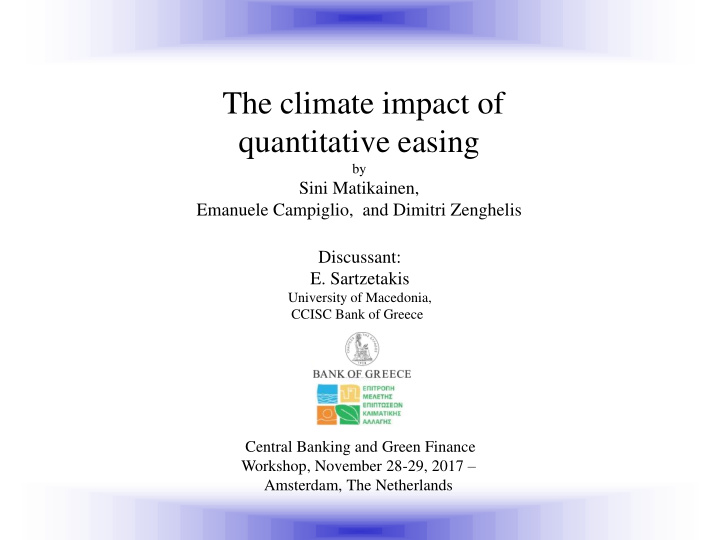



The climate impact of quantitative easing by Sini Matikainen, Emanuele Campiglio, and Dimitri Zenghelis Discussant: E. Sartzetakis University of Macedonia, CCISC Bank of Greece Central Banking and Green Finance Workshop, November 28-29, 2017 – Amsterdam, The Netherlands
1. Introduction BANK OF GREECE Certainty: Continued anthropogenic emission of GHGs will cause further warming of the planet Increased warming will cause physical damages that will impact substantially on both the economy and the society Climate-related extreme events accounted for almost 433 billion (2015 EUR value) of economic losses in the EEA member countries over the period 1980−2015. (2016 EEA Report on Climate change, impacts and vulnerability in Europe) Uncertainty Pose potential threats not only to certain economic sectors but also to financial stability (ex. productivity Integrated assessment Temperature = f(CHGs concentration) shocks). Thus of potential interest to CBs. models (IAMs) Physical impact = g(temperature) Economic impact = h 1 (Physical impact ) Social impact = h 2 (Physical impact ) Apart from the uncertainty related to the magnitude (severity) there is great uncertainty related to the timing of the effects. Uncertainty has resulted in slowing the required actions, which include the transition from fossil fuel energy and related physical assets to clean and energy-efficient technologies. The transition is estimated to require around $1 tr./y The transition to low(zero?)-carbon economy poses potential risks to those depending of fossil fuels. of investments for the foreseeable future. In the same time though it opens up new opportunities World Energy Outlook Special Briefing for COP21, IEA, 2015 E. Sartzetakis The climate impact of quantitative easing 2 / 5
2. Paper’s short presentation BANK OF GREECE The paper briefly discusses the financial risks from climate change, and focuses on presenting and evaluating Central the Banks’ responses. Three types of climate-related financial risk: Physical: risks that could arise from climate and weather-related events, such as floods and storms, which can damage property infrastructure or disrupt trade. Transition: risks that could arise from the process of adjusting to a lower-carbon economy, such as changes in policy, technology, or investor sentiment. (and also stranded assets). Liability: risks that could arise from parties who have suffered loss or damage (effect on insurance sector). Bank of England (2015) “The impact of climate change on the UK insurance sector.”, Prudential Regulation Authority, September 2015 Two main indirect responses by CBs: Requiring transparency of information regarding companies’ emissions and a standardized method to disclose them Developing dedicated climate stress-tests, to better assess the extent of the risk to the financial sector No direct response based on the CBs neutrality and avoidance of distortion arguments The paper explores whether CBs currents policies are indeed carbon neutral E. Sartzetakis The climate impact of quantitative easing 3 / 5
2. Paper’s short presentation BANK OF GREECE Is quantitative easing (QE) neutral? First the authors question the effectiveness of QE in stimulating growth and argue that “QE and loose monetary policy have increased asset prices in the financial markets to a level that is out of step with underlying economic fundamentals” On the carbon impact, the authors argue that CBs, by avoiding market distortion, they reinforce the status quo and thus existing market distortions (responsible for climate change). This is true for purchases of government bonds, lending to certain sectors of the economy (housing market, SMEs) and purchases of corporate bonds. ECB and Bank of England corporate bond purchases ECB’s Corporate Sector Purchase Programme (CSPP) The authors argue that “… the CSPP -eligible universe does not reflect the entire bond market, which does not reflect the real economy, which does not reflect the socially optimal state of low- carbon capital distribution.” Bank of England’s Corporate Bond Purchase Programme Similarly the Bank of England’s eligibility criteria do not allow to target the socially optimal state The authors show (Figures 3 and 4) that both the above programmes’ purchases favor (share in total purchases) sectors (ex. utilities) with low value added and high carbon content (oil and gas companies) Recommendations to CBs: increase purchases’ and selection process’ transparency evaluate the carbon impact of their policies incorporate the above into their policies (eligibility criteria should include environmental and social performance, and/or devise green QE) Coordinate with fiscal policy makers E. Sartzetakis The climate impact of quantitative easing 4 / 5
3. Comments BANK OF GREECE An excellent paper, providing to the point analysis of the effect of QE on the carbon content of the economy and very useful recommendations As the authors mention, although QE is a temporary instrument it might have a, socially undesirable, long run effect on the environment by slowing the transition to low carbon economy This in turn could increase all three types of financial risk Physical and liability: by reinforcing climate change Transition: by postponing the transition and making it more abrupt All the above become more prominent if one takes into account the discussion on long and fat tailed distributions concerning the probability distributions of the response of temperature to GHGs concentrations (Weitzman (2007) finds that the probability that the temperature increases more than 6.2 ο C exceeds 5%. The last IPCC report summarized the distributions of 18 studies resulting in increases 2 – 4.5 o C, with best estimate 3 o C, very unlikely that it will be smaller than 1.5 o C and without being able to exclude increases higher than 4.5 o C). The CBs, especially during the period that through QE their impact is more prominent, they could have a substantial impact if they revise their policies Climate-related financial reporting is extremely important in the long run, by providing information that improves investors’ (at all levels) ability to appropriately assess and price climate -related risk and opportunities. The role of the Task Force on Climate-related Financial Disclosures could be very important if it moves quickly and sets up a workable framework. E. Sartzetakis The climate impact of quantitative easing 5 / 5
Recommend
More recommend